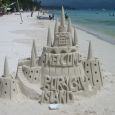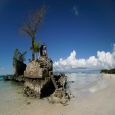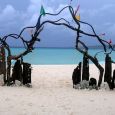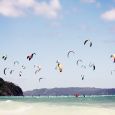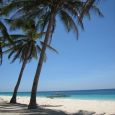Boracay
Advertisement
By plane
There are two airports located near to the island of Boracay.
Caticlan or Godofredo P. Ramos Airport (IATA: MPH) (ICAO: RPVE) - Only small body aircrafts could land in this airport. Airlines with flights to and from Caticlan are South East Asian Airlines(SEAIR), Cebu Pacific Air and Air Philippines from Manila, Cebu and Clark. From the Caticlan airport, you can either take a tricycle (PhP 40.00) or walk (10 minutes) to Caticlan Jetty Port.
Kalibo International Airport (IATA: KLO) (ICAO: RPVK) - Compared to Caticlan's airport, the runway is able to hold aircrafts such as Boeing 737 and Airbus A320 however it is farther from Caticlan's jetty port which is 90 minutes away. Cebu Pacific Air, China Airlines, Philippine Airlines, and Zest Airways connects Kalibo to Manila, Taipei, Shanghai and Seoul. There are minivans, vans, coasters and buses that serve travellers between Kalibo International Aiport and Caticlan Jetty Port. Be sure to ask if your ticket includes a ferry to Boracay (₱200 for a van and ferry), and how much the additional environmental taxes will be (a total of ₱125 on top of your tickets).
By road and ferry
The "Nautical Highway" is a combination of overland highways and roll-on, roll-off (RoRo) vessels that allow you to bring your vehicle up to Panay Island and visit key cities like Kalibo. Taking your car all the way to Boracay, though, is not possible. Public transport also operates on the same route, and is the most cost-effective way of traveling between Manila and Boracay. Assuming good connections, the total journey time is around 12 hours.
The easiest way of arranging this is to book a van in Manila by contacting private operators such as Angel Star (02 783-0886 c/o Abner) and Gope (02 732-6891 c/o Cesar). This will enable you to book a straight trip from Manila to Caticlan at the cost of P1200, more or less. Their group operates several passenger vans which can load 10-14 or 15-18 persons. You book the trip exclusively or share with fellow travellers. The Van leaves at 9PM daily from Manila, travelling through Batangas-Calapan-Roxas (arrives Roxas at 5AM or 6AM) to catch the 8AM or 10AM ferry/boat to Caticlan, where you are expected to arrive between noon to 2PM. Before proceeding to Boracay Island though, be sure to get your return ticket (Roxas-Manila) at the Caticlan Ferry Terminal (inquire about the updated schedule from the staff of the van operators). Take an early dinner before boarding the van and bring water and something to eat while on travel. Riding a van gives you a more relaxed pace to Caticlan because you wouldn't have to stop in many sub-destinations which lengthen your trip and therefore can be truly tiresome.
White Beach
This is what most people are here for. Not only is it a lovely stretch of powdery white sand against azure water, it's also the commercial center of the island. The long beach is divided into three sections, Station 1, Station 2, and Station 3. Station 1 is the northernmost and has the widest beachfront, where prime hotels and resorts are located. Accommodations are pricier, but quality is generally the best as well. Station 2 is the commercial and geographical center of white beach. This is the center of it all for for shopping, eating, partying, and etc. That said, the beach here is also the most crowded, and the area the nosiest. Station 3 is the southernmost section; quieter than station 2, it is the least developed, and also the lowest priced. All of White Beach from the northernmost tip of Station 1 to the southernmost of Station 3 (~4km) is open to the public, so one can relax and/or swim wherever they like, regardless of hotel location.
Puka Beach
A quiet stretch of white sand along the northern tip of the island, Puka Beach is an image of what most people expect on a tropical island: white sand, azure water, and relatively empty. This is where locals gather the small puka shells for some of the jewelry that is sold on the island so expect the sand to be more coarse than on White Beach. The water tends to be a little rougher on this side of the island but it is much quieter. Similarly, there are fewer services -- there are only a couple of restaurants, but you likely won't have a problem getting a cold drink or an ice cream as there are a few vendors that patrol the beach. The main road in Boracay terminates at Puka Beach therefore you'll be able to hire a tricycle to get there in less than 10-15 minutes from central White Beach. Make sure you arrange a pickup if it is a quiet day and no tricycles are hanging around the beach. Most people experience Puka as one of their sailboat or banca stops during a day trip. This is a good spot for a picnic, but be sure to bring your trash home with you.
Baling Hai Beach
This is a quiet little cove just north of Diniwid Beach, where you can enjoy swimming, snorkeling and dining in a relaxed, peaceful environment. There are some fantastic views from the clifftop restaurant. Baling Hai is often included as a stop-off on an island boat tour.
The Bat Cave
One will see in several tour guides and maps of Boracay something called the Bat Cave, which houses many small insectivorous bats (the larger fruit bats roost in the trees on the hillside above Punta Bunga Beach), and locals will be more than happy to accompany you there for a fee, or "tip". The cave is on the western-end of the island and down several dirt roads. The guide will then take you on a short hike through the forest to the mouth of a cave, which drops down at a very steep angle. The mouth of the cave is littered with large boulders, and is extremely difficult to enter and walk down. There is no visible path, no handrail, and the stones are extremely slippery with slime and bat guano, as well as extremely dangerous, since the cave is at such an extreme angle. Also, the air inside the cave is very warm and humid, and in addition to the amount of guano, is very difficult to breathe.
Information not available


